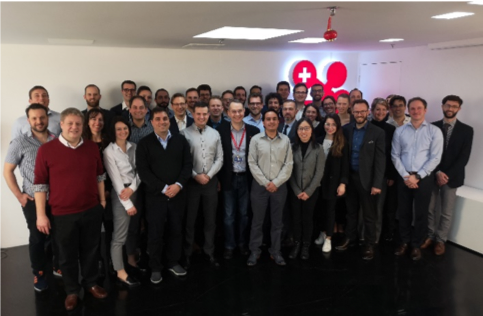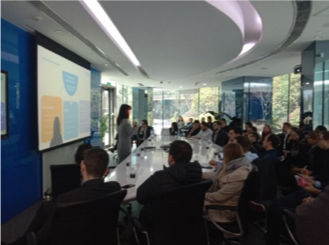By Jun Ma, Board member of ETH Alumni Shanghai Chapter
ETH Alumni Chapter Shanghai organised together with swissnex an alumni event on November 15th, 2019. Our Speaker, Dr. Li Yonghua, formal visiting scholar at ETH, analyzed the causes in aspect of energy consumption and ways to reduce it in China.
ETH Alumni Chapter Shanghai organizes every year several events for the more than 100 alumni living in Shanghai area. This time Dr. Li Yonghua, visiting scholar in 2004-2005 at ETH Zurich, now works as Professor at School of Energy and Power Engineering in North China Electric Power University, spoke on cause of air pollution in China and the ways to reduce it. Dr. Li’s research interests focus on theory and technology of combustion, energy-saving and emission-reduction and new energy utilization technology. The event was hold at swissnex China office and has attracted more than 30 alumni from ETH or other Swiss universities.
Dr. Li Yonghua giving a speech
Dr Li’s speech consists of 3 chapters.
1. China’s resource per capita occupancy level is very low comparing to the world average level: the coal resource is 79% while natural gas and petroleum only 6.5% and 6.1%. As a consequent, the energy structure in 2016 (see the chart as below) shows that 62% energy in China was from coal, which is much more than the 28.1% in the world structure.
World and China Energy Structure
China's coal-based energy structure is determined by resources. China's resource reserves and consumption in 2016:
As we know, except for coal all the other resources (natural gas, petroleum, water, nuclear) are very clean, they don’t emit air pollutants. In contrast with other countries, China has to use coal since coal is the only available energy resource for the rapidly increased energy demand, which means control of coal-fired emission is the key for environmental protection. Therefore, China has applied the strictest environmental protection standard in power industry in the world.
Environmental Protection Standard
The improvement in the last ten years is obvious, data released by the Ministry of Environmental Protection showed that in 2015, sulfur dioxide emissions from exhaust gases totalled 18.591 million tons, down 5.8% from the previous year. Nitrogen oxide emissions totalled 18.518 million tons, down 10.9% from the previous year. The soot emission was 15.38 million tons. Power pollution emissions accounted for less than 10% of total pollution. The emission per unit of coal power generation has reached the world advanced level and China's coal power efficiency is only slightly lower than Japan's, higher than Germany, the United States and other countries. But due to the huge base of coal consumption the total emissions are still very high, it could not be changed until new energy is applied.
2. Coal-fired generation is not the main source of pollution. In fact, for example, when we check sources of PM2.5 in Beijing, we see the coal-fire only makes 19% of the total pollution while automobile makes 25%, food industry 13% and outside transportation 19%. But Beijing has no coal-fired power plants; the coal is consumed by other industries.
Source of PM2.5 Beijing
Ways to reduce pollutions differ in every city and country, but it is difficult everywhere. Energy is an important pillar for the sustainable development of a country or society, but the use of energy will bring environmental pollution. At present, under the global climate change, the deterioration of ecological environment, as well as problems such as resource shortage, all countries in the world attach great importance to energy conservation and emission reduction. Sharing economy is a hot topic to make the city green, but it also brings safety issues. Moving industry out of the city could reduce industrial waste gas emission in the city, but it still remains. The accidents in Chernobyl nuclear power plant and Fukushinia Nuclear Power Plant urge people in the world to re-think nuclear energy. In Switzerland, all current new nuclear power plants will be closed after service.
3. From 2011 to 2040, the Science and technology research and development in China focuses on the clean and efficient utilization of coal (supercritical technology, IGCC, circulating fluidized bed, pollution control, etc.), improve the efficiency of the whole energy system (including the collection, conversion, utilization efficiency of terminal) (energy saving) and optimize the structure of energy (New energy). Ultra-low emission technologies for coal-fired power plants include: low-nitrogen combustion technology, SCR denitrification technology, high-efficiency wet desulfurization technology, wet dust removal technology, etc. After 2050, nuclear fusion, natural gas hydrate, space solar energy and hydrogenic energy could replace the current energy.
After the interesting speech we enjoyed very delicious Swiss style food sponsored by ETH and took a group photo with our most famous alumni, Albert Einstein.
Group photo
About the Author: Jun Ma studied at Department ITET from 1997-2003 and he is board member of ETH Alumni Shanghai Chapter since 2019. He owns a start-up company in China.










































